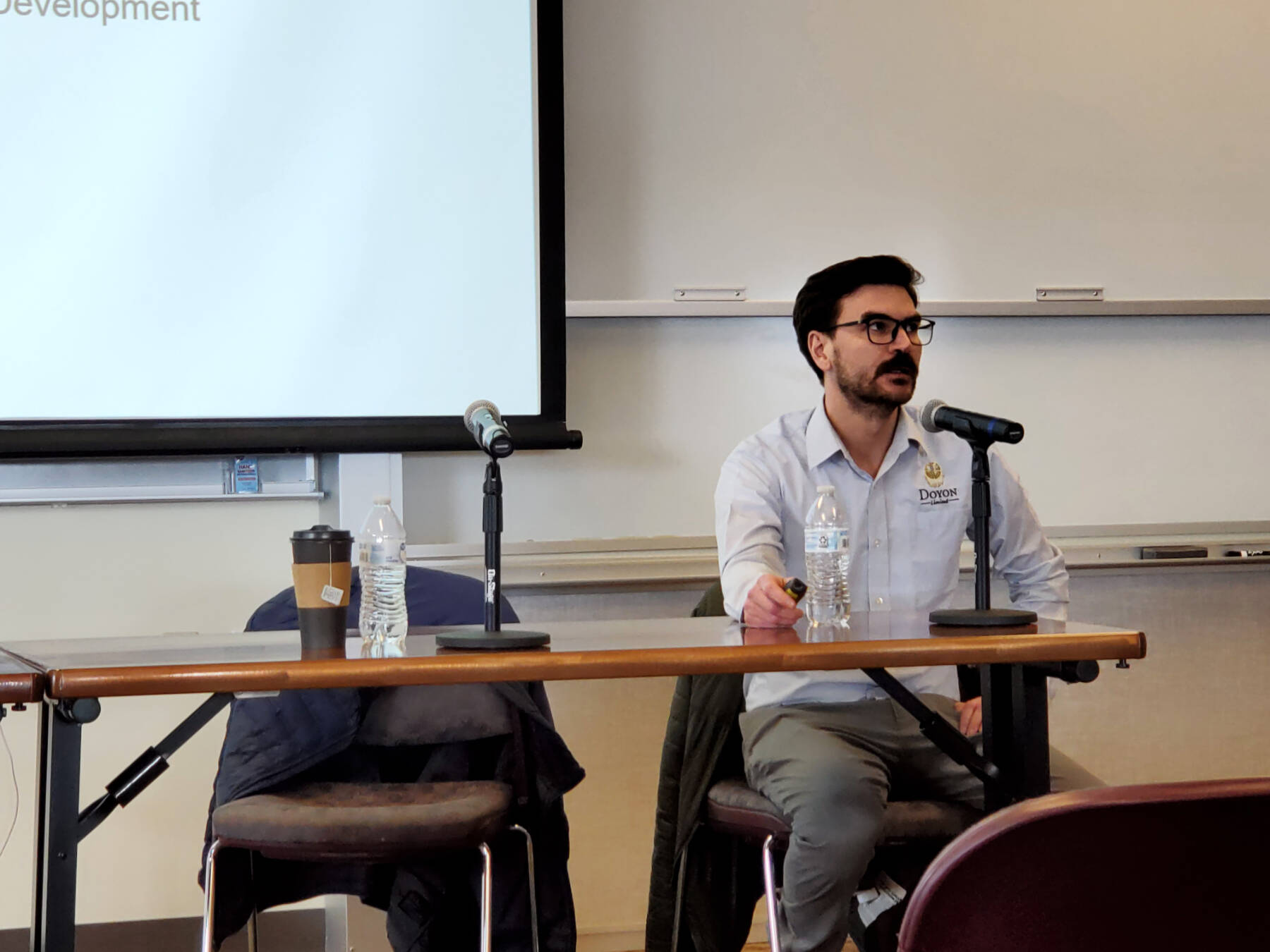Despite the recent failure to move forward on the Lighthouse Village development project, Doyon, Limited isn’t going anywhere, as demonstrated at the members-only luncheon hosted by the Homer Chamber of Commerce last Wednesday, March 6.
“We’re committed to this for the long-term,” Doyon Operations Manager Zach Dunlap said during his presentation to the business owners gathered in Kachemak Bay Campus’s Pioneer Hall. “We’re planning to stay in Homer.”
Doyon initially submitted an application to the Homer Planning Commission on Dec. 6, 2023, that included a conditional use permit for a planned unit development, a request to vacate the B Street right of way south of Bay Avenue, a request to rezone the lot located at 1491 Bay Avenue from rural residential to General Commercial 1, and a preliminary replat consideration.
The Planning Commission recommended approval of the rezone to the Homer City Council, but recommended not approving the ROW vacation or the replat to the council and the Kenai Peninsula Borough Planning Commission, respectively.
The Homer Planning Commission denied Doyon’s application for a conditional use permit in a 6-1 vote on Jan. 31.
During a Q&A session following Dunlap’s presentation, Doyon Senior Vice President and Chief Financial Officer Patrick Duke revealed that the corporation recently filed paperwork to appeal the commission’s denial of the CUP.
“We think that the commission cited a piece of code that’s not valid to our project,” Duke said. “The findings that (they) have, that’s a big box store finding, that’s not applicable to our application.”
During the luncheon, Dunlap gave an overview of the planned development as previously submitted to the city.
Doyon intended to build an 80,000-square-foot hotel with 85 guest rooms on three floors; an accompanying three-story, dormitory-style employee housing unit; and five triplex condo developments, three of which would be marketed for sale with the remaining two designated as “short-stay” units, Homer News previously reported.
Dunlap also described additional “unique aspects” of the development’s current design, including a 5,000-square-foot conference room that could fit about 230 people, a series of public access paths or boardwalks that would connect Bay Avenue to the Homer Spit trail, and a rooftop bar that would “take advantage of the great location of the property (and) be a good asset for the community, for visitors or locals to come and enjoy the view.”
Dunlap concluded his presentation with his “key message” that Doyon’s proposal is an “improvement” to what was previously developed at Lighthouse Village; that Doyon is a developer that “keeps Alaska at the top of its mind;” that Lighthouse Village is “ideally situated” for development with “minimal impacts” on the surroundings; and that the Homer comprehensive plan supports developments like Lighthouse Village.
“We have deep roots in Alaska,” he said. “You won’t find a more Alaskan business than Doyon or any other regional corporation.”
During the Q&A, Homer City Council member Jason Davis, who is also the owner of Sweetgale Meadworks and Cider House, asked Duke and Dunlap if they had ideas for making their hotel better fit it with Homer’s aesthetics and how they saw the way forward for their development.
“There was quite a bit of give and take in terms of design of the hotel,” Duke said. “That was certainly something we heard through the public process, that this hotel doesn’t really look like Homer. I guess my question would be, what does a Homer hotel look like? What is that definition?”
Duke also expressed disappointment that the Lighthouse Village project team “never really got feedback from the Planning Commission on what would it take for this project to get approved,” whether that meant changing, shrinking or excluding some aspects of the development’s design.
“So we’re going to go through that (appeals) process. We hope it’s an iterative process, and we have the ability to have that discussion with the commission and say, ‘OK, what are the things that we need to do to meet the code, and what are the things that we need to change to this design to go back and present that again to the community and the city?’” he said.
Kachemak Bay Conservation Society Board Vice President Penelope Haas asked, in response to Duke’s statement about lack of feedback, “Just now you said that you didn’t get enough clear direction from the planning commission when they gave their findings. I wonder what of all the (public) comments that were so critical of your design that you took to heart?”
“We definitely have heard and read every comment,” Dunlap said. “We addressed some of those in our rebuttal to the commission.”
However, he said, some of the comments received didn’t seem to pertain to the application and hearing process for Doyon’s conditional use permit, but to items that would be relevant “later down the line.”
“This is the start,” Dunlap said. “We’re here to listen to … the feedback from the community and bring that to an iterative process with the planning commission when we get back in front of them.”
Duke echoed Dunlap’s response.
“We’re not here to develop something just to say, ‘By God, it’s going to be this design, and if we can get that through the city process then that’s what we’re going to build.’ There is going to be that process, a healthy give-and-take, if you will, to get that public response. We’re going to listen as much as we can, but at some point, a decision has got to be made that, again, meets the code of what the city has said is acceptable,” he said.


